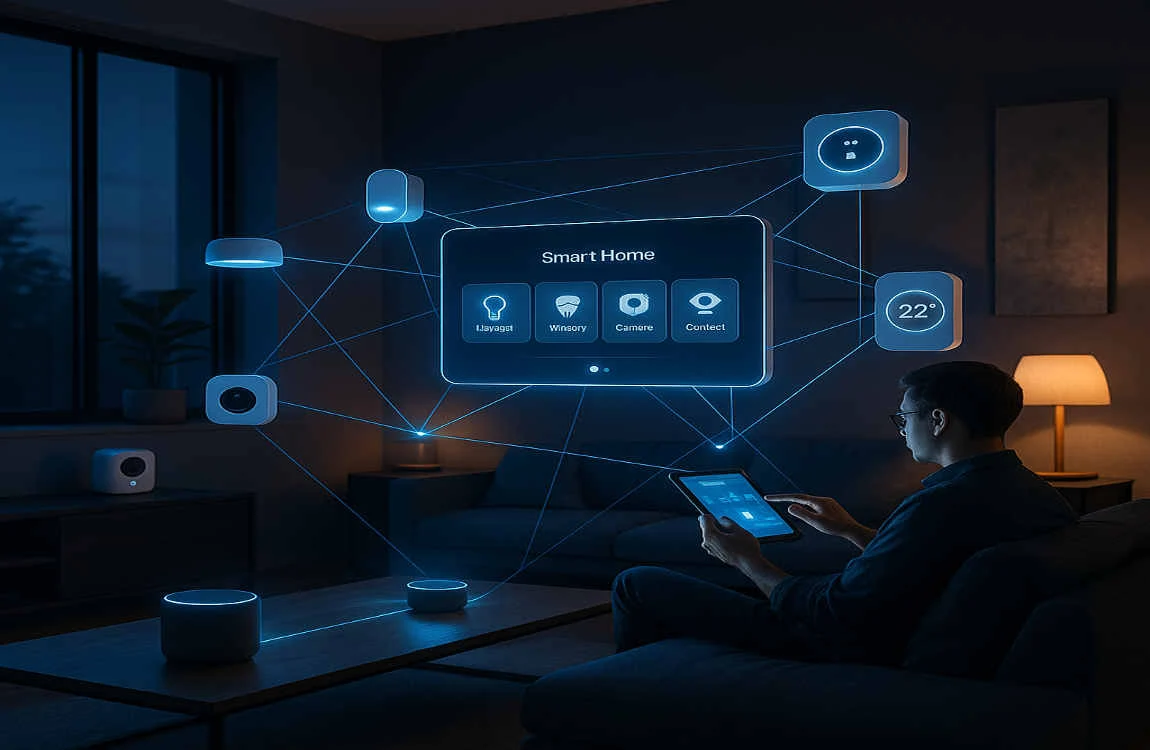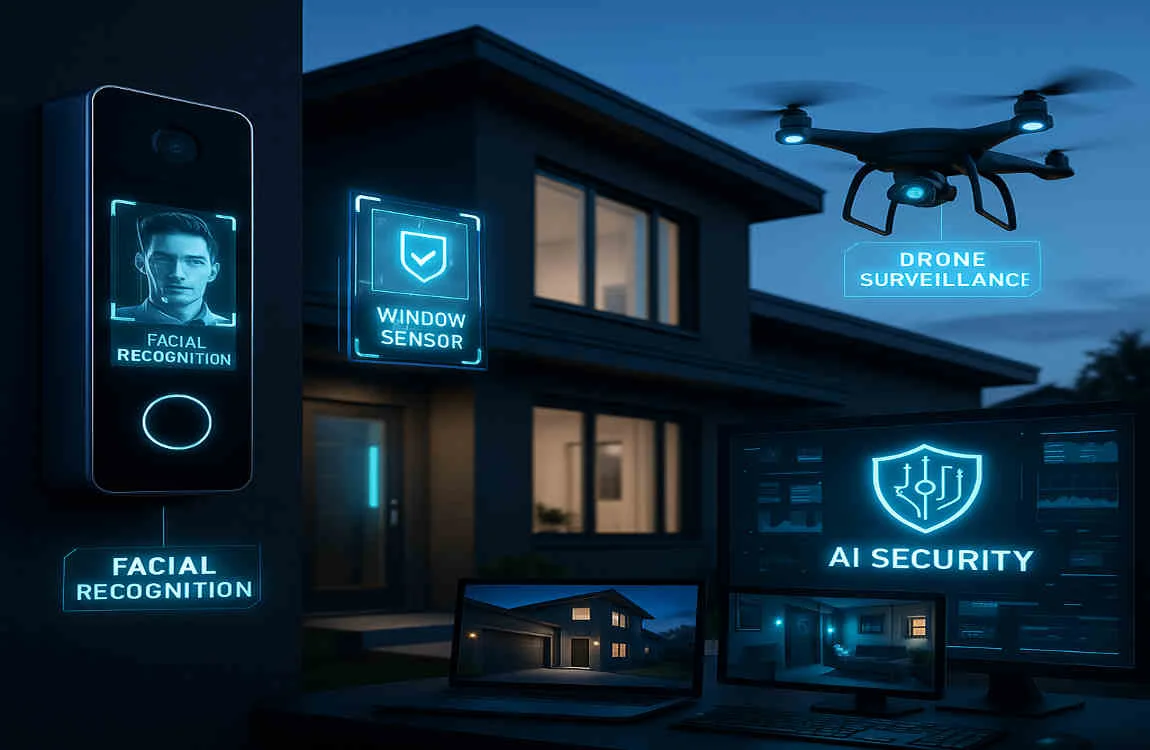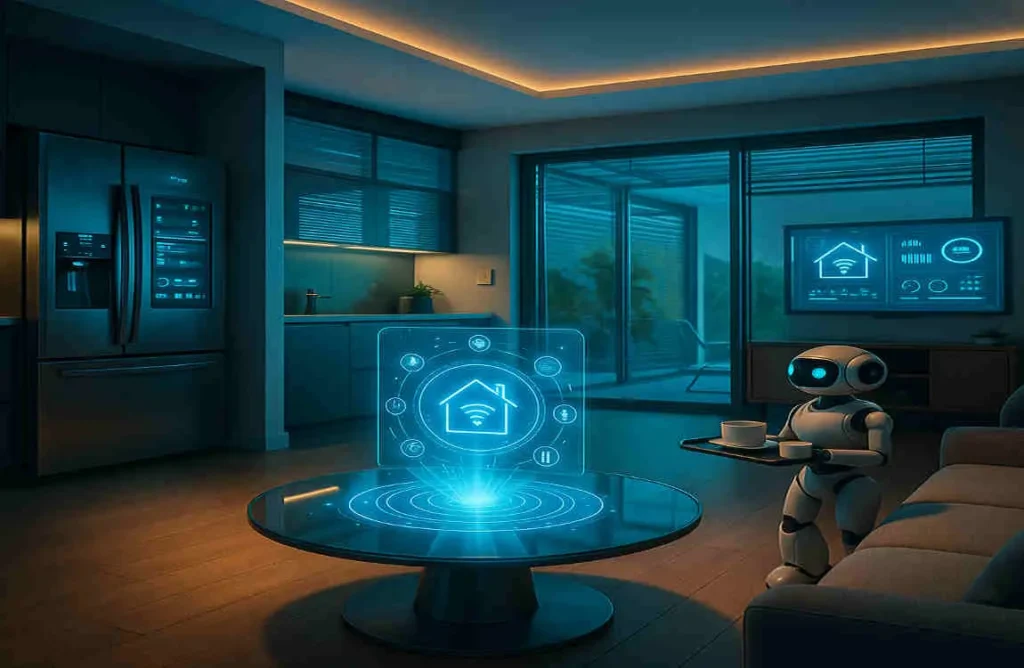Imagine waking up in a home that knows you better than you know yourself. Your lights gently brighten as the sun rises, your coffee brews at the perfect temperature, and your thermostat adjusts to keep things cozy without wasting energy. This isn’t science fiction—it’s the reality of future home technology that’s rapidly changing how we live. Home technology has come a long way from simple gadgets to interconnected systems that make life easier, safer, and more efficient.
Why is this evolution happening so fast? Well, think about our busy lives. We juggle work, family, and everything in between. Future home technology steps in to handle the little things, like turning off forgotten lights or alerting you to a leaky pipe before it becomes a flood. It’s all about convenience, but it goes deeper. These innovations boost security, reduce energy bills, and even improve our health by creating more innovative living spaces.
In 2025, we’re seeing a boom in these technologies, driven by advances in artificial intelligence, better connectivity, and a push for sustainability. Homes are becoming “smart” in ways that feel magical yet practical. Whether you’re a tech enthusiast or just someone who wants an easier daily routine, understanding these trends can help you upgrade your space.
The Rise of Smart Home Integration: The Backbone of Future Home Technology

Understanding Smart Home Integration and IoT
Smart home integration is like giving your house a brain. It connects all your devices so they talk to each other and work as a team. At the heart of this is the Internet of Things, or IoT for short. IoT simply means everyday objects—like your fridge or doorbell—get hooked up to the internet. This lets them send and receive data, making your home more responsive.
Picture this: You walk in the door, and your lights turn on automatically while your favorite playlist starts playing. That’s integration in action. In 2025, future home technology relies on this seamless teamwork to create personalized experiences. No more fumbling with remotes; everything syncs up through apps or voice commands.
How Interconnected Devices Create Seamless Control
Centralized control systems are the real game-changers here. Think of them as the command center for your home. Devices from different brands can now communicate via hubs like smart speakers. This means your thermostat chats with your windows to optimize airflow, saving energy without you lifting a finger.
Advancements in smart speakers, such as Amazon’s Alexa or Google Assistant, use AI to understand natural language. You can say, “Hey, dim the lights for movie night,” and it happens instantly. These voice assistants learn from you over time, getting smarter with each interaction.
Key Examples of Smart Devices in Action
Let’s break it down with some real-world examples. Smart thermostats, like the Nest Learning Thermostat, adjust temperatures based on your schedule. Connected lighting systems let you control brightness and color from your phone. And don’t forget smart kitchen appliances—ovens that preheat themselves or fridges that remind you to buy milk.
The future home technology landscape relies heavily on advanced smart home integration to deliver personalized automation and convenience. It’s not just about gadgets; it’s about creating a home that adapts to you. What devices do you already have that could be connected more effectively? Upgrading to integrated systems might be easier than you think.
To make this more straightforward, here’s a quick list of benefits:
- Ease of Use: Control everything from one app.
- Energy Savings: Devices optimize usage automatically.
- Customization: Tailor settings to your lifestyle.
As we move forward, AI takes this integration to the next level by adding prediction and automation.
AI-Powered Automation and Predictive Technology
How AI Learns and Automates Your Home
You may also read (5 tips to stop fleas from spreading in your house).
Artificial intelligence, or AI, is like a helpful roommate who remembers your habits. In future home technology, AI analyzes how you use your home—when you wake up, what temperature you prefer—and automates routines accordingly. It turns off lights you forget, locks doors at night, and even starts your morning routine.
This isn’t magic; it’s data-driven. AI systems collect info from sensors and devices, then make intelligent decisions. For instance, if it notices you always turn up the heat in winter evenings, it does it for you. This makes homes more efficient and less hands-on.
Predictive Maintenance: Stopping Problems Before They Start
One of the coolest parts? Predictive maintenance. AI spots issues in appliances before they break down. Your washing machine might send an alert saying, “Hey, my filter needs cleaning soon,” preventing a costly repair.
Take the Google Nest Thermostat as an example. It’s AI tracks energy patterns and suggests tweaks to save on bills. It even predicts weather changes to adjust heating proactively. AI automation is central to future home technology, making homes more responsive and efficient. Imagine the peace of mind knowing your home is always one step ahead.
Real Benefits for Everyday Life
AI doesn’t just save time; it also optimizes energy. By learning your patterns, it reduces waste, like dimming lights when no one’s in the room. This leads to lower utility bills and a greener planet.
Have you thought about how AI could simplify your day? Start small, like with a smart plug that learns your coffee maker’s schedule. Over time, these features build a truly automated home.
Here’s a simple table comparing traditional vs. AI-powered homes:
Feature Traditional HomeAI-Powered Home
Temperature Control Manual adjustments Auto-adjusts based on habits and weather
Maintenance Alerts React after breakdown Predicts and notifies in advance
Energy Use Often wasteful Optimized for savings
User Interaction : Frequent manual input, Learns and automates routines
AI sets the stage for even more unified systems, like the Matter protocol.
Universal Connectivity with Matter Protocol: Solving Compatibility Issues
What Is the Matter Protocol?
Matter is a new standard that’s like a universal language for smart devices. Developed by tech giants like Apple, Google, and Amazon, it ensures gadgets from different brands work together without hiccups. No more frustration when your bright bulb won’t connect to your hub.
In future home technology, Matter is a cornerstone, unifying smart device ecosystems. It launched recently and is gaining traction in 2025, making setups more straightforward for everyone.
Benefits of Interoperability
The big win? Compatibility. You can mix and match devices without being locked into one brand. Setup is a breeze—plug in, connect, and you’re good. Plus, it boosts security with encrypted connections, keeping hackers at bay.
Matter also means faster responses and better reliability. Your lights, locks, and thermostats all sync seamlessly, creating a truly integrated home.
Why It Matters for Your Home
Think about expanding your smart setup. With Matter, you avoid the headache of incompatible tech. It’s eco-friendly too, as it encourages longer device lifespans. Matter is a cornerstone in future home technology, unifying smart device ecosystems and opening doors to innovation.
Ready to check if your devices are Matter-compatible? It’s a smart move for future-proofing your home.
Advanced Home Security Innovations

AI in Surveillance and Threat Detection
Home security has evolved from basic alarms to intelligent systems. AI-powered cameras now use facial recognition to spot familiar faces versus strangers. They detect unusual activity in real-time, sending alerts to your phone instantly.
For example, cameras like those from Ring or Arlo analyze movements and even predict potential threats, like someone lingering too long at your door. This is a key part of future home technology, turning passive monitoring into active protection.
Biometric Locks for Safer Access
Gone are the days of lost keys. Biometric smart locks use fingerprints, facial scans, or even palm recognition for entry. They’re tough to fool and integrate with your phone for remote access.
You can grant temporary access to guests via an app, and voice control lets you lock up with a simple command. It’s convenient and secure—perfect for busy families.
Integration and Remote Monitoring
These systems tie into your smart home hub, so your security camera talks to your lights, turning them on if motion is detected at night. Mobile apps give you live feeds and instant notifications, no Matter where you are.
Home security innovations are essential in future home technology, providing peace of mind. How secure is your home right now? Upgrading to these could make a big difference.
Consider this numbered list of tips for better security:
- Install AI Cameras: Choose ones with night vision and two-way audio.
- Opt for Biometric Locks: Ensure they have backup power options.
- Integrate with Apps: Set up notifications for unusual activity.
Security pairs well with sustainability, our next topic.
Sustainable and Energy-Efficient Technologies
The Push for Greener Homes
Sustainability is huge in future home technology. We all want to reduce our carbon footprint, and innovative tech makes it easy. Energy-efficient devices monitor usage and cut waste, helping the planet and your wallet.
Smart thermostats learn your habits to heat or cool only when needed. Solar power integration lets homes generate their own energy, storing excess in batteries for later.
Key Innovations in Energy Monitoring
Energy monitoring systems track every watt, showing you where to save. Apps break it down by device, so you see if that old fridge is guzzling power.
Innovations like air quality monitors, such as the Airthings Renew, link to your HVAC system. They detect pollutants and adjust ventilation, improving indoor health while saving energy.
Eco-Friendly Materials and Devices
Look for devices made from recycled materials with low-energy modes. Smart plugs turn off standby power vampires, like chargers left plugged in.
Energy-efficient smart devices are vital in future home technology, promoting sustainability. What small change could you make today? Switching to LED smart bulbs is a great start.
Next-Level Comfort and Wellness Technologies
Tech for Better Comfort
Future home technology isn’t just about smarts; it’s about feeling good. Brilliant furniture adjusts to your posture, like chairs that shift for better ergonomics during work-from-home days.
Massage chairs with app controls target sore spots, and tech-enhanced sleep aids, such as motion-sensing pillows, ensure restful nights.
Immersive Wellness Experiences
Customizable lighting, like LIFX Luna bulbs, mimics natural sunlight to boost mood. Aromatherapy systems infuse scents into baths for relaxation.
These innovations create a spa-like home environment. Future home technology is not just innovative and secure; it aims to improve wellness and quality of life.
How do you unwind? Adding an innovative diffuser could elevate your routine.
Innovative Cleaning and Maintenance Solutions
Smart Robots Taking Over Chores
Cleaning just got effortless with AI robots. They navigate rooms, avoiding obstacles, and handle vacuuming, mopping, and even air purification all at once.
Examples include the Eufy 3-in-1 Vacuum or Roborock S6 Series. These bots learn your home’s layout and schedule cleanings automatically.
You may also read (how to save on expensive home plumbing services).
Reducing Household Labor
Automation means less time scrubbing floors. Sensors detect dirt levels and focus on high-traffic areas.
In future home technology, these solutions maintain cleanliness with minimal effort. Imagine coming home to spotless floors—sounds great, right?
The Impact of 5G and IoT Expansion on Home Technology
5G brings lightning-fast internet to homes, supercharging IoT networks. Devices respond quicker, with less lag, making voice commands instant.
This expansion supports more connected gadgets without slowdowns. Future home technology benefits from scalability, letting you add devices easily.
Lower latency means reliable video calls or seamless security feeds. It’s the backbone for all these innovations.
Practical Tips for Embracing Future Home Technology
Ready to dive in? Start with interoperability—choose Matter-compatible devices.
Prioritize security: Use strong passwords and enable two-factor authentication.
For energy efficiency, invest in smart thermostats first.
Leverage voice assistants to tie everything together. Stay updated via tech blogs or apps.
What’s your first upgrade? Small steps lead to a smarter home.
You may also read (what are the different types of house handrails available).
